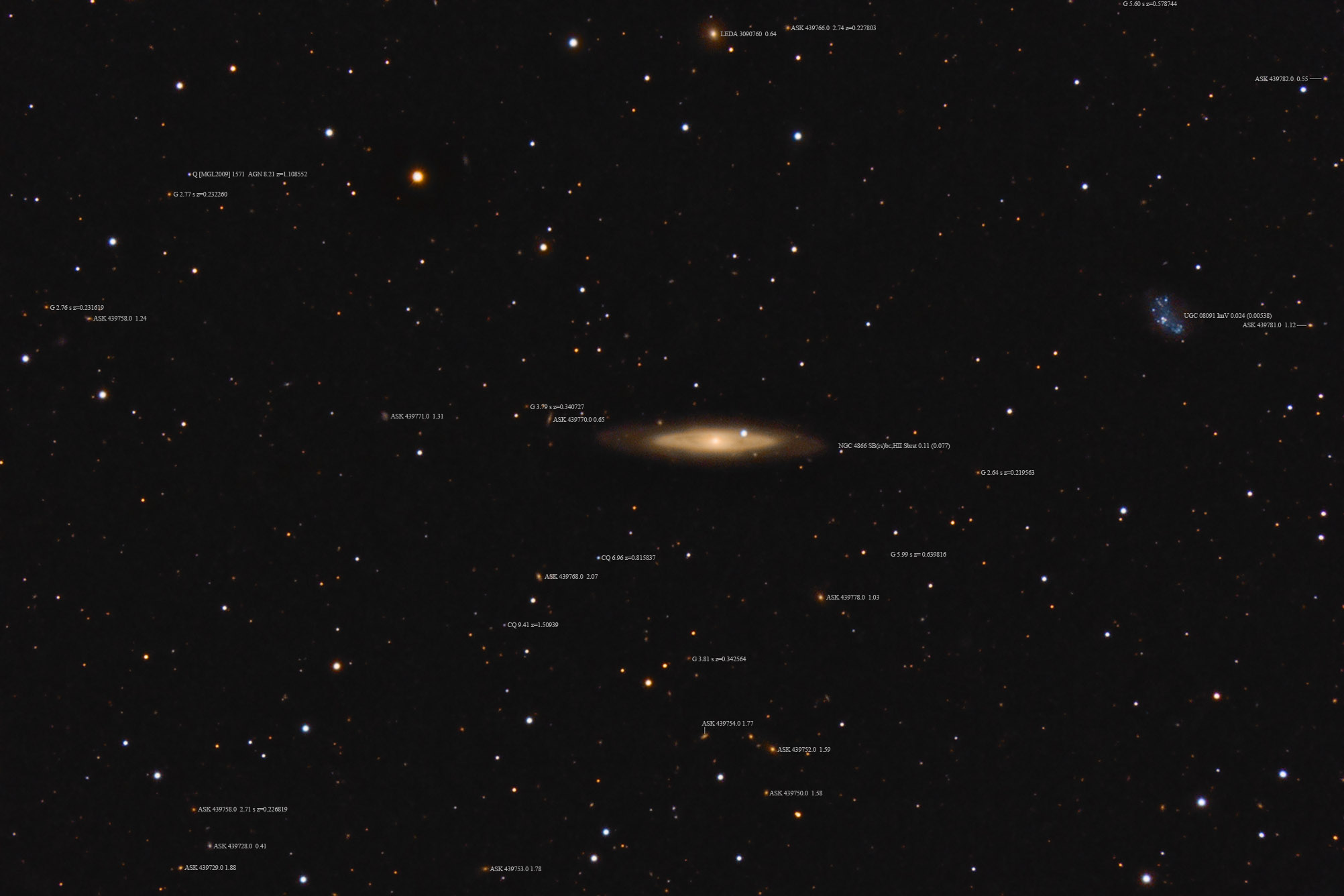Object name: NGC4866 A study in blue and gold
NGC 4866 at first appears to be a red and dead galaxy. Maybe not. NED classifies it as a starburst galaxy. The thick covering dust seems to hide this at visual wavelengths. High-resolution images show very thin dark dust lanes superimposed on the blah red disk. NED's classification is SB(rs)bc; HII Sbrst. It sees a barred rather open armed bc type galaxy. That certainly doesn't fit pure visual images of it but may reflect IR and radio views of the galaxy. Seligman goes with the more visual saying it is SA0(r)a?. Other have yet other opinions. One says: "NGC 4866 is seen almost edge on. It is classed as Sa because it is clearly not an S0; there is dust throughout the disk in what appears to be a spiral pattern...It is not as late as Sb, judged from the lack of resolution of the disk into knots (HII regions) or stellar associations." This has my head spinning faster than the galaxy. An HST image of much, but not all, of the galaxy, can be found here: http://cseligman.com/text/atlas/ngc4866hst.jpg note that east is at the top in the HST image. He doesn't say what wavelengths are being used for this blue version of the galaxy.
Even more interesting to me is UGC 08091. It is classed as an irregular Magellanic galaxy. It is likely a distant member of the local group at a bit over 5 million miles distant. That may put it just beyond the local group. In any case, it is a very irregular and sparse galaxy. Redshift puts it 24 million light-years distant which doesn't begin to fit what I'm imaging. Redshift can be very inaccurate at close distances. Assuming the little over 5 million light-year distance I measure it at only 2,400 light-years in size. Now that's a small galaxy. NGC 4886 is 191,000 light-years across if the 110 million light-year distance is right. Since that is almost impossibly big the non-redshift distance of 77 million light-years may be more correct. That still makes it very large at 133 million light-years.
The rest of the field had limited distance information so the annotated image has fewer galaxies noted. Many more are in the image, they just don't have redshift data at NED, at least at the time this was annotated.
The image is mostly in very northern Virgo. LEDA 3090760 at the top of the frame is just barely in Coma Berenices.
14" LX200R @ f/10, L=4x10' RGB=2x10, STL-11000XM, Paramount ME Related Designation(s):11HUGS 316, 2MASS J12584041+1413027, 2MASS J12584042+1413025, 2MASS J12592707+1410163, 2MASX J12592713+1410157, 2MFGC 10288, ALFALFA 1-449, ALFALFA 1-452, CGCG 071-087, CGCG 071-092, CGCG 1256.2+1429, CGCG 1257.0+1427, DDO 155, EVCC 2253, EVCC 2254, GALEXASC J125926.98+141015.1 , GR 08, HIPASS J1259+14, Imprint of a Foot, LDCE 0904 NED287, LSBC D646-07, MAPS-NGP O_437_0647322, MCG +02-33-041, MCG +02-33-045, NGC 4866, NGC4866, NSA 142659, NSA 142722, NSA 169968, PGC 044491, PGC 044600, SDSS J125840.44+141303.0, SSTSL2 J125840.43+141303.1, UGC 08091, UGC 08102, UGC08091, USGC U490 NED03, USGC U509 NED03, UZC J125840.3+141302, UZC J125927.2+141018, UZC-CG 178 NED02, VIII Zw 222, VV 558, [BEC2010] HRS 286, [RC2] A1256+14, [SPB93] 203, [TCW2007] 133, [ZSK75] 1256.1+1414, | | 

